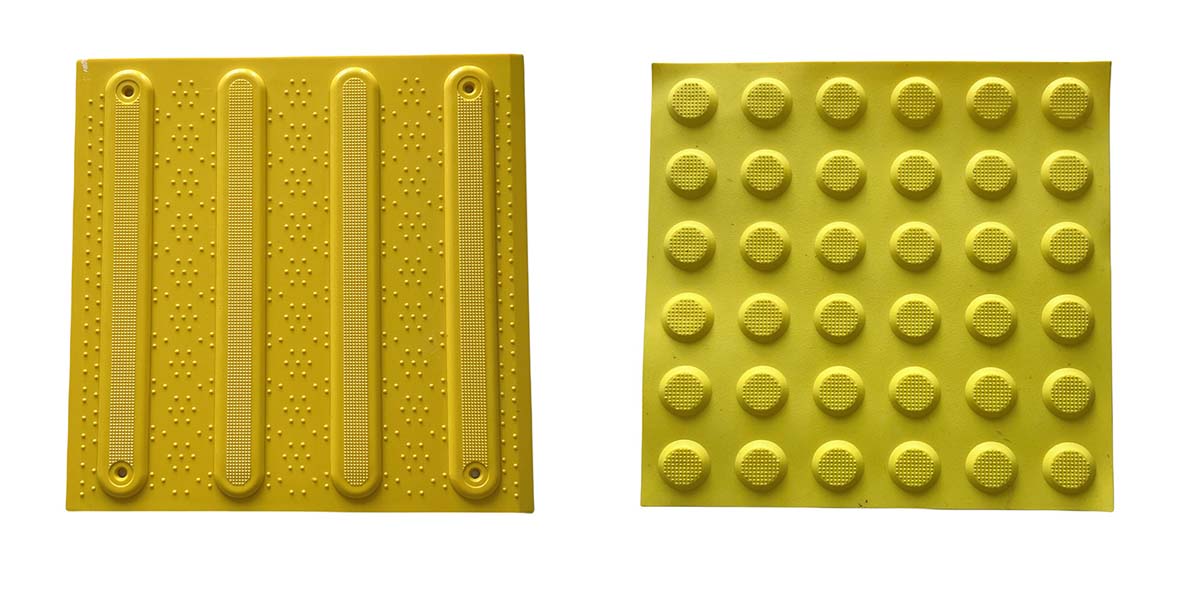What Are You Looking For?
Tactile paving,also known as braille blocks,is a critical innovation designed to assist visually impaired individuals in navigating public spaces safely and independently.These tactile paving blocks come in various materials,each tailored to specific environments and user needs.This article explores the three primary materials used—PVC,rubber,and ABS—along with their unique characteristics and applications.

Materials and Characteristics
1\.PVC Tactile Paving
PVC(Polyvinyl Chloride)is a versatile and widely used material for tactile paving.It is known for its durability and resistance to weather conditions,making it an ideal choice for outdoor applications.PVC tactile paving can be manufactured in varying degrees of hardness.For outdoor settings,such as sidewalks and public squares,a harder version is typically used to withstand heavy foot traffic and environmental factors like rain,snow,and UV exposure.
However,PVC can also be produced in softer forms,which are more suitable for indoor environments.These softer PVC blocks often come with an adhesive backing,facilitating easy installation in large public spaces like subway stations,train stations,and hospitals.The adhesive ensures that the blocks remain securely in place,providing consistent tactile feedback for visually impaired individuals.
2\.Rubber Tactile Paving
Rubber tactile paving is another popular option,particularly valued for its flexibility and resilience.Rubber's inherent softness makes it an excellent choice for indoor installations where a gentle touch is preferred.The soft texture of rubber blocks ensures that they are comfortable underfoot,reducing the risk of injury from accidental falls.Like PVC,rubber tactile paving can also be equipped with a self-adhesive backing for convenient installation.
The flexibility of rubber allows it to conform to uneven surfaces,ensuring that the tactile patterns remain consistent and recognizable.This adaptability is crucial in environments where the floor may not be perfectly flat,such as in older buildings or areas with frequent maintenance work.
3\.ABS Tactile Paving
ABS(Acrylonitrile Butadiene Styrene)is a robust and impact-resistant material that offers a balance between durability and tactile sensitivity.ABS tactile paving blocks are often chosen for their ability to withstand heavy use without losing their structural integrity.They are particularly well-suited for high-traffic areas,such as shopping malls,airports,and large public facilities.
ABS blocks can be manufactured with varying levels of hardness to meet specific requirements.For outdoor use,a harder version is preferred to resist wear and tear from the elements.Indoors,a slightly softer variant can be used,especially in areas where comfort and ease of installation are priorities.Like PVC and rubber,ABS tactile paving can also be produced with a self-adhesive backing for quick and secure installation.
Design and Functionality
One of the key features of tactile paving is the raised patterns on the surface,which provide clear and distinct tactile feedback for visually impaired individuals.These patterns are designed to be easily recognizable by touch,guiding users safely through pedestrian crossings,along pathways,and around obstacles.
The height and shape of the raised patterns are carefully engineered to ensure that they are noticeable underfoot but not so high as to pose a tripping hazard.The patterns are typically uniform,allowing visually impaired individuals to develop a consistent sense of direction and spatial awareness.
Customization and Aesthetics
Tactile paving is not only functional but also visually appealing.The color of the blocks can be customized to match the surrounding environment or to provide a high-contrast visual cue for individuals with low vision.Yellow and gray are the most commonly used colors due to their high visibility and aesthetic compatibility with various architectural styles.
Yellow tactile paving is often chosen for its bright and eye-catching appearance,making it easy to spot even from a distance.Gray,on the other hand,offers a more subdued and elegant look,blending seamlessly with modern and traditional designs alike.The ability to customize the color of tactile paving ensures that it can be integrated harmoniously into any public space,enhancing both functionality and aesthetics.
Tactile paving plays a vital role in creating inclusive and accessible environments for visually impaired individuals.The availability of PVC,rubber,and ABS materials,each with adjustable hardness and customizable features,ensures that tactile paving can be tailored to meet the specific needs of different settings.Whether installed outdoors or indoors,in hard or soft forms,and in various colors,tactile paving remains a crucial tool in promoting independence and safety for visually impaired people.As cities and public spaces continue to evolve,the importance of tactile paving will only grow,highlighting its significance in modern urban planning and design.
If you need anything, please contact us,Customized different size/color/shape rubber/pvc products, making molds depending on your samples or drawings. FREE SAMPLES can be sent for your evaluation!
Over 20 years Professional Experience in Auto Accessories Field